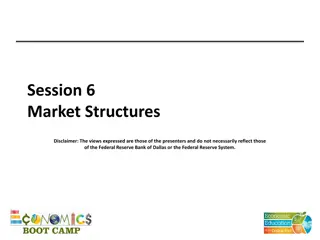Understanding Oligopoly in Microeconomics
Introduction to oligopoly, a market structure between perfect competition and pure monopoly. In oligopoly, only a few sellers offer similar or identical products, leading to a balance between cooperation and self-interest. Characteristics of an oligopoly market include interdependence among firms and the tendency to act like a monopolist. The concept of a duopoly, the simplest form of oligopoly with only two members, is also discussed.
Download Presentation

Please find below an Image/Link to download the presentation.
The content on the website is provided AS IS for your information and personal use only. It may not be sold, licensed, or shared on other websites without obtaining consent from the author. Download presentation by click this link. If you encounter any issues during the download, it is possible that the publisher has removed the file from their server.
E N D
Presentation Transcript
Chapter 17 Oligopoly Introduction to Microeconomics Udayan Roy
BETWEEN MONOPOLY AND PERFECT COMPETITION Imperfect competition refers to those market structures that fall between perfect competition and pure monopoly. CHAPTER 17 OLIGOPOLY
BETWEEN MONOPOLY AND PERFECT COMPETITION Imperfect competition includes industries in which firms have competitors but do not face so much competition that they are forced to be price takers. CHAPTER 17 OLIGOPOLY
BETWEEN MONOPOLY AND PERFECT COMPETITION Types of Imperfectly Competitive Markets Oligopoly Only a few sellers, each offering a similar or identical product to the others. Monopolistic Competition Many firms selling products that are similar but not identical. CHAPTER 17 OLIGOPOLY
The Four Types of Market Structure Number of Firms? Many firms Type of Products? One firm Few firms Differentiated products Identical products Monopolistic Competition (Chapter 16) Perfect Competition (Chapter 14) Monopoly (Chapter 15) Oligopoly (Chapter 17) Tap water Cable TV Tennis balls Crude oil Novels Movies Wheat Milk CHAPTER 17 OLIGOPOLY
MARKETS WITH ONLY A FEW SELLERS Because of the few sellers, the key feature of oligopoly is the tension between cooperation and self-interest. CHAPTER 17 OLIGOPOLY
MARKETS WITH ONLY A FEW SELLERS Characteristics of an Oligopoly Market Few sellers offering similar or identical products Interdependent firms Best off cooperating and acting like a monopolist by producing a small quantity of output and charging a price above marginal cost CHAPTER 17 OLIGOPOLY
A Duopoly Example A duopoly is an oligopoly with only two members. It is the simplest type of oligopoly. CHAPTER 17 OLIGOPOLY
Table 1 The Demand Schedule for Water Assumption: Marginal Cost of producing water is zero: MC = 0. Monopoly Duopoly Perfect Competition
A Duopoly Example Price and Quantity Supplied In a perfectly competitive market: P = MC = $0 Q = 120 gallons In a monopoly price would be where total profit is maximized: P = $60 Q = 60 gallons CHAPTER 17 OLIGOPOLY
Competition, Monopolies, and Cartels The duopolists may agree on a monopoly outcome. Collusion An agreement among firms in a market about quantities to produce or prices to charge. Cartel A group of firms acting in unison. CHAPTER 17 OLIGOPOLY
Competition, Monopolies, and Cartels Although oligopolists would like to form cartels and earn monopoly profits, often that is not possible. Antitrust laws prohibit explicit agreements among oligopolists. CHAPTER 17 OLIGOPOLY
The Equilibrium for an Oligopoly A Nash equilibrium is a situation in which economic actors interacting with one another each choose their best strategy given the strategies that all the others have chosen. CHAPTER 17 OLIGOPOLY
The Equilibrium for an Oligopoly When each firm in an oligopoly chooses its own production to maximize its own profit, taking the other firms outputs as given, they collectively produce more than the level produced by a monopoly and less than the level produced in perfect competition. CHAPTER 17 OLIGOPOLY
The Equilibrium for an Oligopoly Therefore, the oligopoly price is less than the monopoly price but greater than the competitive price (which equals marginal cost). CHAPTER 17 OLIGOPOLY
Equilibrium for an Oligopoly: Summary Joint output is greater than the monopoly quantity but less than the competitive industry quantity. Market prices are lower than monopoly price but greater than competitive price. Total profits are less than the monopoly profit. CHAPTER 17 OLIGOPOLY
How the Size of an Oligopoly Affects the Market Outcome Recall from Ch. 15: How an increase in production affects price and profit: The output effect: Because price is above marginal cost, selling more at the going price raises profits. (+) The price effect: Raising production will increase the amount sold, which will lower the price and the profit per unit on all units sold. ( ) CHAPTER 17 OLIGOPOLY
How the Size of an Oligopoly Affects the Market Outcome As the number of firms in the oligopoly increases, the price effect becomes weaker. As a result, the output effect determines firms behavior: firms feel encouraged to boost production as long as P > MC. CHAPTER 17 OLIGOPOLY
How the Size of an Oligopoly Affects the Market Outcome As the number of sellers in an oligopoly grows larger, an oligopolistic market looks more and more like a competitive market. The price approaches marginal cost, and the quantity produced approaches the socially efficient level. CHAPTER 17 OLIGOPOLY
THE ECONOMICS OF COOPERATION Game theory is the study of how people behave in strategic situations. Strategic decisions are those in which each person, in deciding what actions to take, must consider how others might respond to that action. CHAPTER 17 OLIGOPOLY
THE ECONOMICS OF COOPERATION Because the number of firms in an oligopolistic market is small, each firm must act strategically. Each firm knows that its profit depends not only on how much it produces but also on how much the other firms produce. CHAPTER 17 OLIGOPOLY
The Prisoners Dilemma The prisoners dilemma is a game that provides insight into the difficulty in maintaining cooperation. Often people (firms) fail to cooperate with one another even when cooperation would make them better off. CHAPTER 17 OLIGOPOLY
The Prisoners Dilemma The prisoners dilemma is a particular game between two captured prisoners that illustrates why cooperation is difficult to maintain even when it is mutually beneficial. CHAPTER 17 OLIGOPOLY
Figure 1 The Prisoners Dilemma Bonnie s Decision Confess Remain Silent Bonnie gets 8 years Bonnie gets 20 years Confess Clyde gets 8 years Clyde goes free Clyde s Decision Bonnie goes free Bonnie gets 1 year Remain Silent Clyde gets 20 years Clyde gets 1 year Can you predict what these two perps will do?
The Prisoners Dilemma The dominant strategy is the best strategy for a player to follow regardless of the strategies chosen by the other players. In the Prisoners Dilemma game, each player s dominant strategy is to confess. And yet, they would both be better off if they remained silent The pursuit of self interest leads to misery for all. (Sorry, Mr. Adam Smith.) CHAPTER 17 OLIGOPOLY
The Prisoners Dilemma Cooperation is difficult to maintain, because cooperation is not in the best interest of the individual player. The Prisoners Dilemma is an apt metaphor for many social situations in which we d all be better off if we cooperated, but we don t This lesson applies to the duopoly analysis we saw earlier CHAPTER 17 OLIGOPOLY
Oligopolies as a Prisoners Dilemma Self-interest makes it difficult for the oligopoly to maintain a cooperative outcome with low production, high prices, and monopoly profits. CHAPTER 17 OLIGOPOLY
Figure 2 Jack and Jills Oligopoly Game Jack s Decision Sell 40 Gallons Sell 30 Gallons Jack gets $1,600 profit Jack gets $1,500 profit Sell 40 Gallons Jill gets $1,600 profit Jill gets $2,000 profit Jill s Decision Jack gets $2,000 profit Jack gets $1,800 profit Sell 30 Gallons Jill gets $1,500 profit Jill gets $1,800 profit CHAPTER 17 OLIGOPOLY
Figure 2 Jack and Jills Oligopoly Game Jack s Decision Low production: 30 gallons High production: 40 gallons Jack gets $1,600 profit Jack gets $1,500 profit High production: 40 gallons Jill gets $2,000 profit Jill gets $1,600 profit Jill s Decision Jack gets $1,800 profit Jack gets $2,000 profit Low production: 30 gallons Jill gets $1,500 profit Jill gets $1,800 profit Can you predict what Jack and Jill will do?
Other examples of the prisoners dilemma Arms races Common resources CHAPTER 17 OLIGOPOLY
Figure 3 An Arms-Race Game Decision of the United States (U.S.) Arm Disarm U.S. at risk U.S. at risk and weak Arm Decision of the Soviet Union (USSR) USSR at risk USSR safe and powerful U.S. safe and powerful U.S. safe Disarm USSR at risk and weak USSR safe CHAPTER 17 OLIGOPOLY
Figure 3 An Arms-Race Game USA Decision Arm Disarm USA at risk USA at risk and weak Arm USSR safe and powerful USSR at risk USSR Decision USA safe and powerful USA safe Disarm USSR safe USSR at risk and weak Can you predict what USA and USSR will do?
Figure 4 A Common-Resource Game Exxon s Decision Drill Two Wells Drill One Well Exxon gets $4 million profit Exxon gets $3 million profit Drill Two Wells Texaco gets $4 million profit Texaco gets $6 million profit Texaco s Decision Exxon gets $6 million profit Exxon gets $5 million profit Drill One Well Texaco gets $3 million profit Texaco gets $5 million profit CHAPTER 17 OLIGOPOLY
Figure 4 A Common-Resources Game Exxon s Decision Drill Two Wells Drill One Well Exxon gets $4 million profit Exxon gets $3 million profit Drill Two Wells Texaco gets $4 million profit Texaco gets $6 million profit Texaco s Decision Exxon gets $6 million profit Exxon gets $5 million profit Drill One Well Texaco gets $3 million profit Texaco gets $5 million profit Can you predict what Exxon and Texaco will do?
The prisoners dilemma and the welfare of society CHAPTER 17 OLIGOPOLY
Why People Sometimes Cooperate Firms that care about future profits will cooperate in repeated games rather than cheating in a single game to achieve a one-time gain. CHAPTER 17 OLIGOPOLY
The prisoners dilemma tournament CHAPTER 17 OLIGOPOLY
PUBLIC POLICY TOWARD OLIGOPOLIES Cooperation among oligopolists is undesirable from the standpoint of society as a whole because it leads to production that is too low and prices that are too high. CHAPTER 17 OLIGOPOLY
Restraint of Trade and the Antitrust Laws Antitrust laws make it illegal to restrain trade or attempt to monopolize a market. Sherman Antitrust Act of 1890 Clayton Act of 1914 CHAPTER 17 OLIGOPOLY
Controversies over Antitrust Policy Antitrust policies sometimes may not allow business practices that have potentially positive effects: Resale price maintenance Predatory pricing Tying CHAPTER 17 OLIGOPOLY
Controversies over Antitrust Policy Resale Price Maintenance (or fair trade) occurs when suppliers (like wholesalers) require retailers to charge a specific amount Predatory Pricing occurs when a large firm begins to cut the price of its product(s) with the intent of driving its competitor(s) out of the market Tying when a firm offers two (or more) of its products together at a single price, rather than separately CHAPTER 17 OLIGOPOLY
Any Questions? CHAPTER 17 OLIGOPOLY
Summary Oligopolists maximize their total profits by forming a cartel and acting like a monopolist. If oligopolists make decisions about production levels individually, the result is a greater quantity and a lower price than under the monopoly outcome. CHAPTER 17 OLIGOPOLY
Summary The prisoners dilemma shows that self-interest can prevent people from maintaining cooperation, even when cooperation is in their mutual self-interest. The logic of the prisoners dilemma applies in many situations, including oligopolies. CHAPTER 17 OLIGOPOLY
Summary Policymakers use the antitrust laws to prevent oligopolies from engaging in behavior that reduces competition. CHAPTER 17 OLIGOPOLY























